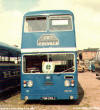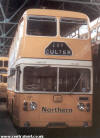Special Features Focus on : Fleetline Failures
Contributed by Douglas G MacDonald, 2003
The old adage once bitten, twice shy is not a phrase associated with Central’s management, when looking back at their vehicle-buying policy. In 1962/63, the company purchased 30 Albion Lowlanders, but they were disposed of in 1965, being scattered around other Bus Group operators. Then, of course, came – and went – the Bristol VRs. Having failed to impress Central SMT and indeed the other SBG companies, they were sold off to NBC counterparts in exchange for late models of the FLF.
So to mid-1971, and perhaps the Traction House hierarchy were hoping for third time lucky when an intake was made of 35 brand new Daimler Fleetlines with with ECW (Series 2) double-deck H43/34F bodies. They were assigned fleet numbers D1-35, a designation previously used on wartime Daimlers. Although fitted with PAYE signs and ticket machine mountings, these buses started their Central lives as crew-operated vehicles, deployed mostly on the company’s high-frequency trunk services linking Lanarkshire with Glasgow.
Initially, it appeared that all was well with the Gardner 6LXB-engined ‘deckers – one mechanic at Airbles reckoned the TGM in their registrations could have stood for Technically Good Motors, and although the Fleetline marque already had a sound reputation nationwide, the writing was on the wall for Central’s batch within only 3 years. By the summer of ’74, rumours were rife that the Fleetlines were being considered for withdrawal with, perhaps ironically, the Bristol Omnibus Co. being the favoured recipient. However, interest expressed by other SBG members meant no cross-border move and a change of destiny for the Daimlers. Over the winter of ’75 into ’76 the entire batch was distributed as follows, in chronological order :-
D21 – 29 Alexander (Midland)
D1 – 20 Eastern Scottish
D30 – 35 Alexander (Northern)
There appears to be no definitive answer to the question as to why Central chose to ditch a proven vehicle type in an operating area which generally required high-capacity buses. On asking ex-CSMT employees, including drivers, management and maintenance staff, possible reasons include standardisation on Leyland Leopards (whose increasing numbers were further augmented by those received in exchange for the Fleetlines), crew resistance to high-capacity ‘deckers, and even vandalism.
In hindsight it was the wrong move to make. The Fleetlines enjoyed long working lives with their new (and in many cases, subsequent) owners, and the ScotMAP surveys of the late 70s underlined the need for ‘deckers in many operating areas.
The photographs selected for this feature show the Fleetlines in Central times and working with other operators, and the table below details their individual histories, as far as I have been able to trace. If anyone can supply further information, or better still news of any survivors, I’d be delighted to hear from you!
Central SMT D1-35 (TGM 201-235J) Daimler Fleetline ECW H43/34F
D1 | Eastern Scottish DD281 -- Highland D38 (1983) -- scrapped 1988? |
D2 | Eastern Scottish DD282 -- Deans Forest, Joys Green (1983) -– Redcar Marines Band (1986) -– scrapped 1988 |
D3 | Eastern Scottish DD283 -- withdrawn 1983, scrapped by 1984 |
D4 | Eastern Scottish DD284 -- Highland D46 (1983) -– scrapped by 1989? |
D5 | Eastern Scottish DD285 -- Stonier, Tunstall (1983) -- scrapped 1987 (after de-roofing accident) |
D6 | Eastern Scottish DD286 -- scrapped by 1984 |
D7 | Eastern Scottish DD287 -- Highland D47 (1983) -- ?? |
D8 | Eastern Scottish DD288 -- scrapped 1983 |
D9 | Eastern Scottish DD289 -- Highland D48 (1983) -– withdrawn 1988, scrapped by 1989 |
D10 | Eastern Scottish DD290 -- scrapped by 1984 |
D11 | Eastern Scottish DD291 -- scrapped by 1984 |
D12 | Eastern Scottish DD292 -- Highland D49 (1983) -– withdrawn /scrapped 199? |
D13 | Eastern Scottish DD293 -- Highland D40 (1983) -- Wright,Manston(1988) -- scrapped 1990? |
D14 | Eastern Scottish DD294 -- Preserved at SVBM, Lathalmond |
D15 | Eastern Scottish DD295 -- Highland D41 (1983) -– withdrawn and scrapped 1986 (after accident) |
D16 | Eastern Scottish DD296 -- scrapped 1983 |
D17 | Eastern Scottish DD297 -- Highland D39 (1983) -- ?? |
D18 | Eastern Scottish DD298 -- Highland D42 (1983) -- ?? |
D19 | Eastern Scottish DD299 -- Highland D43 (1983) -– Hunter, Garston(1988) -- ?? |
D20 | Eastern Scottish DD300 -- Kinross Motors /Motor Auctions -- Farmer? Or scrapped ?? |
D21 | Alexander (Midland) MRF111 –- Strathtay Scottish SD1 (1985) -– Northern Scottish, not operated and returned to Strathtay –- dealer -- ? |
D22 | Alexander (Midland) MRF112 -– Kelvin Scottish F112 (1985) -– Kent or Welsh independent(??) 1986 and withdrawn by 1988 |
D23 | Alexander (Midland) MRF119 -- withdrawn 1985 & scrapped |
D24 | Alexander (Midland) MRF115 –- Kelvin Scottish F115 (1985), renumbered 1501 in 1987 -– North East Bus Services, Gateshead -- ?? |
D25 | Alexander (Midland) MRF118 -- cannibalised for spares 1986 by SBG Engineering |
D26 | Alexander (Midland) MRF 116 –- Kelvin Scottish F116 (1985), renumbered 1502 in 1987 -– North East Bus Services, Gateshead -- ?? |
D27 | Alexander (Midland) MRF113 –- Kelvin Scottish F113 (1985) -– Welsh Independent(??) 1986 -- ??? 1987 |
D28 | Alexander (Midland) MRF114 -- ?? Band, Wrexham (1987) -- ?? |
D29 | Alexander (Midland) MRF117 -- Kelvin Scottish F117 (1985) – Independent?? 1986 -– Jones, Rochdale 1987 -- ?? |
D30 | Alexander (Northern) NRF 1 -- scrapped 1985 |
D31 | Alexander (Northern) NRF 2, renumbered NDT3 as Driver Trainer 1985, reinstated as NRF2 1986 -– Irvine, Law 1986/7 -- ?? |
D32 | Alexander (Northern) NRF 3 -- scrapped 1985 |
D33 | Alexander (Northern) NRF 4 -- Strathtay Scottish SD2 (1985) -– scrapped 1987 |
D34 | Alexander (Northern) NRF 5 -- withdrawn and scrapped 1987 |
D35 | Alexander (Northern) NRF 6 -- Lowland Scottish 835 (1985) -– scrapped 1987 |









